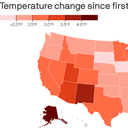The U.S. has seen a dramatic temperature increase since the first Earth Day

Since the first Earth Day on April 22, 1970, the U.S. national average temperature has climbed by 2.6°F, and the states have warmed — many significantly.
Why it matters: Earth Day is supposed to be a symbol of the environmental movement, originally born out of air and water pollution. But now it's a reminder of human-caused climate change — which is leading to more frequent and severe heat waves and wildfires, stronger hurricanes and heavier precipitation events.
By the numbers: Out of 49 states with sufficient data and 246 cities examined by researchers at Climate Central, a climate communications nonprofit group, each state and 244 of the cities saw temperatures climb in the past 52 years.
The numbers that tell the story:
- 30%: The increase in the atmospheric concentration of heat-trapping carbon dioxide in the atmosphere since 1970.
- 7.7°F: The amount Reno, Nev. has warmed since 1970, putting it first on the list of fastest-warming cities. Other cities in the Southwest saw large increases as well, reflecting the drying trend in the region, as well as expanding urban populations and shifting atmospheric circulation consistent with global warming.
- 4.3°F: The total average warming in Alaska during the past 52 years, earning it the title of the fastest-warming state. Climate projections have consistently showed that higher latitudes would warm faster than the rest of the world.
In addition to the Southwest, the Mid-Atlantic and Northeast are also seeing rapidly rising temperatures, with Vermont experiencing a 3-degree increase.
What's next: Recent reports from the U.N.'s top climate panel starkly showed how climate change is affecting the planet in transformative ways, and that the world is not on course to meet the temperature targets laid out in the Paris Agreement.
- However, scientists have shown that limiting warming will be less costly than suffering from its consequences, and a portfolio of solutions already exist to tackle the problem.